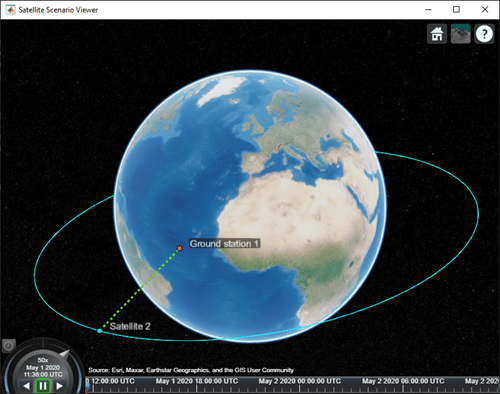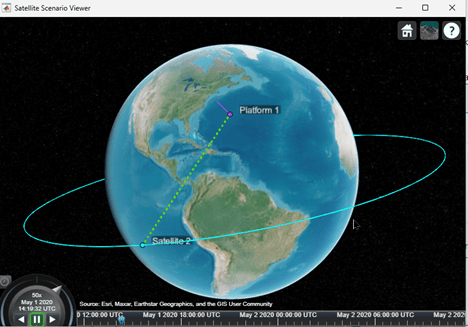Access
Description
The Access object defines an access analysis object belonging to a Satellite, GroundStation, ConicalSensor, or Platform object. Use this
object to determine if the line-of-sight (LOS) between two objects exists.
Also,
If one of the objects belongs to
GroundStation, the MinElevationAngle property of theGroundStationobject limits the LOS visibility.If one of the objects belongs to
ConicalSensor, the MaxViewAngle property of theConicalSensorobject limits the LOS visibility.
For more information see, Algorithms.
Creation
You can create an Access object using the access object function of
Satellite, GroundStation, ConicalSensor, or Platform.
Properties
Object Functions
show | Show object in satellite scenario viewer |
accessStatus | Status of access between first and last node defining access analysis |
accessIntervals | Intervals during which access status is true |
accessPercentage | Percentage of time when access exists between first and last node in access analysis |
hide | Hide satellite scenario entity from viewer |
Examples
Algorithms
In order for access to exist:
Between two satellites, line of sight must exist between the two satellites.
Between a satellite and a ground station, line of sight must exist between the two. In addition, the elevation angle of the satellite and the ground station must be greater than the MinElevationAngle of the ground station.
Between two ground stations, line of sight must exist between the two and the elevation angle with respect to one another must be above the MinElevationAngle of the other.
Between a conical sensor not attached to the satellite, line of sight must exist between the conical sensor and the satellite and the satellite must be in the field of view of the conical sensor. The field of view is a region of cone whose vertex is at the conical sensor location and extends indefinitely along the z axis of the cone. The cone angle is defined by the MaxViewAngle of the conical sensor. In addition, if the conical sensor is attached to a ground station (directly or via a gimbal), the elevation angle of the satellite with respect to that ground station must be greater than or equal to each MinElevationAngle of the ground station. There is always access between the conical sensor and the satellite, if the conical sensor is attached to the same satellite
Between two conical sensors not attached to the same satellite, line of sight must exist between the two sensors, and each sensor must be inside the field of view of the other. If a conical sensor is attached to a ground station, the elevation angle of the other conical sensor with respect to the ground station must be greater than or equal to the MinElevationAngle. There is always access between two conical sensors, if the conical sensors are attached to the same satellite or ground station directly or via gimbals
Between a conical sensor not attached to a ground station, there must be line of sight between the two, the elevation angle of the conical sensor with respect to the ground station must be greater than or equal to its MinElevationAngle, and the ground station must be inside the field of view of the sensor. there is always access if the conical sensor is attached to this ground station directly or via a gimbal
The above just described access between two nodes. However, you can have more than two nodes by chaining them, such as going from a ground station to a conical sensor on a satellite, then down to another ground station. In such a case, access must exist between each individual pair of adjacent nodes. For instance:
sc = satelliteScenario; sat = satellite(sc,10000000,0,0,0,0,0); c = conicalSensor(sat); gs1 = groundStation(sc); gs2 = groundStation(sc,0,0);
ac = access(gs1,c,gs2); s = accessStatus(ac,sc.StartTime)
s will be true when there is access between gs1 and c, and c and gs2. Also, the following must be true at sc.StartTime:
Line of sight must exist between gs1 and c.
Elevation angle of c with respect to gs1 must be greater than or equal to
MinElevationAngleof gs1.gs1 must be inside the field of view of c.
Line of sight must exist between c and gs2.
Elevation angle of c with respect to gs2 must be greater than or equal to
MinElevationAngleof gs2.gs2 must be inside the field of view of c.
For more information, see Satellite Constellation Access to Ground Station.
Version History
Introduced in R2021a
See Also
Objects
Functions
show|play|hide|groundStation|conicalSensor|transmitter|receiver|satellite

